
Weevils are beetles belonging to the superfamily Curculionoidea, known for their elongated snouts. They are usually small – less than 6 mm in length – and herbivorous. Approximately 97,000 species of weevils are known. They belong to several families, with most of them in the family Curculionidae. It also includes bark beetles, which while morphologically dissimilar to other weevils in lacking the distinctive snout, is a subfamily of Curculionidae. Some other beetles, although not closely related, bear the name "weevil", such as the biscuit weevil, which belongs to the family Ptinidae.
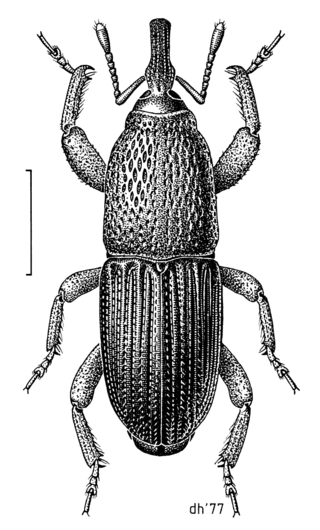
The wheat weevil, also known as the grain weevil or granary weevil, is an insect that feeds on cereal grains, and is a common pest in many places. It can cause significant damage to harvested stored grains and may drastically decrease crop yields. The females lay many eggs and the larvae eat the inside of the grain kernels.
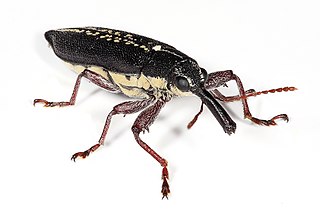
Belidae is a family of weevils, called belids or primitive weevils because they have straight antennae, unlike the "true weevils" or Curculionidae which have geniculate (elbowed) antennae. They are sometimes known as "cycad weevils", but this properly refers to a few species from the genera Parallocorynus and Rhopalotria.

Brentidae, sometimes known as the primitive weevils, is a cosmopolitan family of primarily xylophagous beetles also known as straight-snouted weevils. The concept of this family has been expanded with the inclusion of three groups formerly placed in the Curculionidae; the subfamilies Apioninae, Cyladinae, and Nanophyinae, as well as the Ithycerinae, previously considered a separate family. They are most diverse in the tropics, but occur throughout the temperate regions of the world. They are among the families of weevils that have non-elbowed antennae, and tend to be elongate and flattened, though there are numerous exceptions.
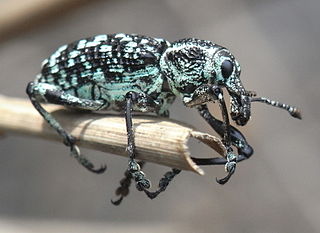
Chrysolopus spectabilis is a species of weevil found in south-eastern Australia. It was discovered during James Cook's first voyage, and became one of the first insects to be described from Australia. The weevil measures up to 25 mm (1.0 in) long and includes distinctive metallic green and black scales. It is found only on 28 species of the plant genus Acacia.

The palm weevil Rhynchophorus ferrugineus is one of two species of snout beetle known as the red palm weevil, Asian palm weevil or sago palm weevil. The adult beetles are relatively large, ranging between 2 and 4 centimetres long, and are usually a rusty red colour—but many colour variants exist and have often been classified as different species. Weevil larvae can excavate holes in the trunks of palm trees up to 1 metre (3.3 ft) long, thereby weakening and eventually killing the host plant. As a result, the weevil is considered a major pest in palm plantations, including the coconut palm, date palm and oil palm.

Larinus is a genus of true weevils, comprising about 180 species, mostly in the Palaearctic region with some species introduced to North America. Turkey appears to have a significant diversity of the group, with more than 50 species recorded in the eastern part of the country.

Baridinae is a subfamily of true weevils (Curculionidae). It was established by Carl Johan Schönherr in 1836. Some 4,300 species in 550 genera are placed here, most of which occur in the New World. A few are economically significant pests, while others are in turn used for biocontrol of invasive plant pests. This subfamily also contains a few endangered species.
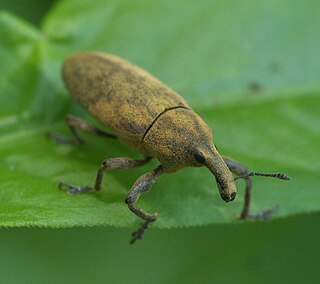
Lixus concavus, commonly called the rhubarb curculio, is a species of weevil. Rhubarb is a host, together with dock, sunflower, and thistle.
Larinus pollinis is a species of cylindrical weevils belonging to the family Curculionidae and the subfamily Lixinae.

Araecerus fasciculatus, the coffee bean weevil, is a species of beetle (Coleoptera) belonging to the family Anthribidae. Despite its name, it affects a wide range of stored products and some field crops and is accredited with consuming more than 100 different kinds of stored goods. This polyphagous insect is often found in stored crops such as: corn, cassava, sweet potatoes, nutmeg, dried fruits and various nuts. Through trade it has become cosmopolitan in its distribution and is considered an economically important global pest. A. fasciculatus causes significant damage to stored food goods, can result in loss of mass quantities of product and can reduce the quality of the stored goods.

Liparus coronatus is a species of beetles belonging to the family Curculionidae.
Lixus parcus, the knotweed weevil, is a species of snout or bark beetle in the family Curculionidae. It is found in North America.
Lixus musculus is a species of true weevil in the beetle family Curculionidae. It is found in North America.
Lixus mucidus is a species of true weevil in the beetle family Curculionidae. It is found in North America.
Lixus asper is a species of true weevil in the beetle family Curculionidae. It is found in North America.
Lixus merula is a species of true weevil in the beetle family Curculionidae. It is found in North America.
Lixus punctinasus is a species of true weevil in the beetle family Curculionidae. It is found in North America.
Diocalandra frumenti, commonly known as the palm weevil borer, the lesser coconut weevil, or four-spotted coconut weevil, is a species of weevil in the family Curculionidae. It occurs in Africa, Southern Asia and Northern Australia, and is a pest of coconut and other palm trees.
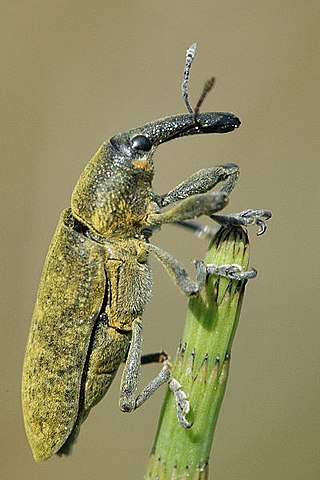
Lixus pulverulentus is a species of weevil belonging to the family Curculionidae. The species was scientifically described in 1763 by Giovanni Antonio Scopoli as Curculio pulverulentus Scopoli, 1763.














